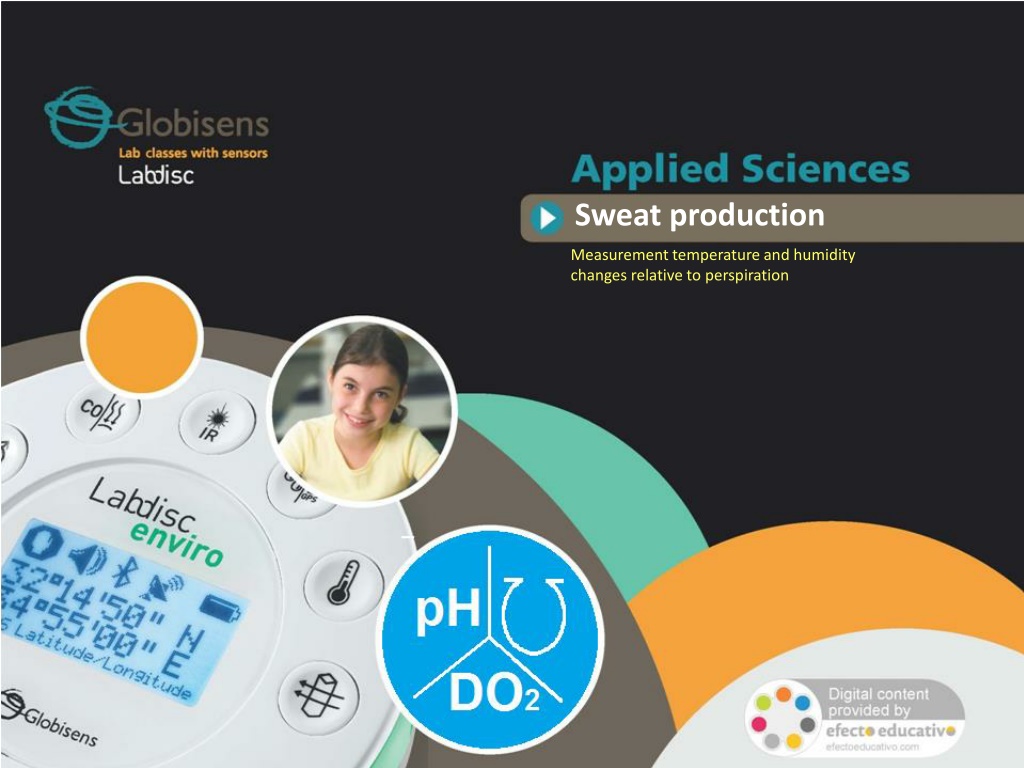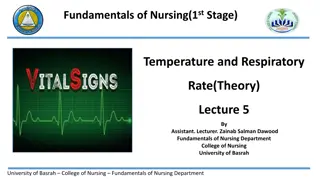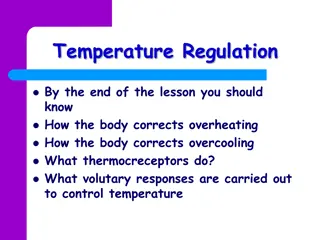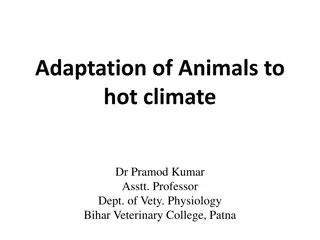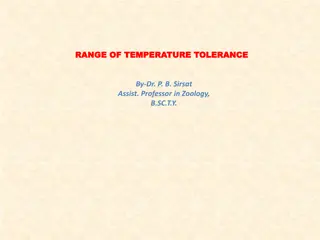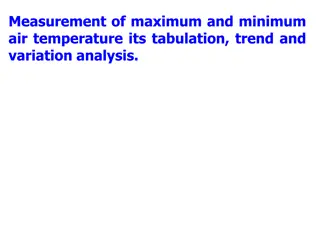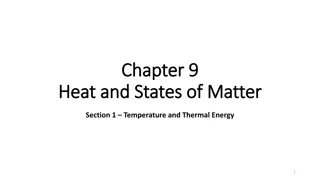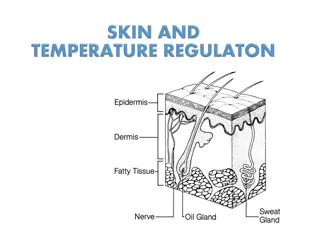Exploring Sweat Production and Temperature Regulation in the Body
This experiment focuses on measuring skin temperature and sweat production to understand the body's cooling mechanism. Through observations of perspiration in response to temperature and stress, participants investigate the relationship between body humidity and environmental temperature. Theoretical concepts of perspiration in plants and animals are also explored, highlighting the importance of this physiological process for maintaining metabolic functions.
Download Presentation

Please find below an Image/Link to download the presentation.
The content on the website is provided AS IS for your information and personal use only. It may not be sold, licensed, or shared on other websites without obtaining consent from the author. Download presentation by click this link. If you encounter any issues during the download, it is possible that the publisher has removed the file from their server.
E N D
Presentation Transcript
Sweat production Measurement temperature and humidity changes relative to perspiration
Sweat production Measurement of temperature and humidity changes relative to perspiration Objective The purpose of this activity is to study our body s cooling system while measuring skin temperature and sweat production. We will create a hypothesis and proceed to test it using the Labdisc humidity and temperature sensors.
Sweat production Measurement of temperature and humidity changes relative to perspiration Introduction and theory Have you ever experienced very high temperatures or felt extreme stress? Your body will have responded by exuding little drops of water through the pores of your skin. Usually we think of this as unpleasant or irritating because it makes our clothes wet and can even make us smell bad. However, perspiration is a very important physiological process that is vital in maintaining our body temperature via the evaporation of water for thermoregulation.
Sweat production Measurement of temperature and humidity changes relative to perspiration Introduction and theory In what types of situation do we usually produce a lot of sweat? How does it feel when the sweat evaporates on your skin? How does it feel when the sweat evaporates on your skin? Carry out the experiment activity with your class so that at the end you ll be able to answer the following question: During the process of perspiration what is the relationship between the humidity of a body and environmental temperature?
Sweat production Measurement of temperature and humidity changes relative to perspiration Introduction and theory Theoretical Perspiration is a physiological mechanism used by plants and animals for various functions like excretion of salts, toxins and other waste products. In plants, the process of excess water disposal produced after photosynthesis or in a hot environment is called transpiration. These organisms are able to control this mechanism by blocking the stomata (microscopic pores on the epidermis of land plants, which also allows gas exchange processes). This way, plants are able to avoid water losses due to evapotranspiration. In some animals, such as humans, this moisture is called sweat. Sweat is exuded though the pores of the skin, eliminating toxins through a body reflex that maintains body temperature, in order to keep stable the normal metabolic functions of the cells.
Sweat production Measurement of temperature and humidity changes relative to perspiration Introduction and theory The molecular structure of water has very unique chemical and physical properties. One of them is the high specific heat index, where water can absorb a lot of heat before it raises its temperature (this property is called thermal inertia). To increase or decrease only one degree centigrade of temperature, water has to absorb or liberate a lot of thermal energy. To change the physical phase from liquid to gas, it liberates another quantity of energy (latent heat) without changing its temperature. Previous characteristics are important because they cause impact in the environmental temperature, when considering the environmental humidity as a large amount of water molecules suspended in the air. If we reach some point in the steam saturation curve, water starts to condense without changing its temperature. We can conclude that water acts as a temperature regulator between the liquid and the gas phase, transferring slowly the heat from one to the other, until it reaches a thermal equilibrium.
Sweat production Measurement of temperature and humidity changes relative to perspiration Introduction and theory Now students are encouraged to raise a hypothesis which must be tested with an experiment. What do you think happens with humidity and temperature rates of the air surrounding a body that sweats profusely?
Sweat production Measurement of temperature and humidity changes relative to perspiration Activity description During this activity we will isolate a system, consisting of a student s hand and the Labdisc, from the environment using a plastic bag and adhesive tape. For 10 minutes, we will monitor the environmental temperature and humidity inside the bag with the GlobiLab software, observing a graph showing the variations of the parameters mentioned earlier. Students should relate the physiological response, indicated by the perspiration process, to the environmental humidity and temperature variations. They should understand the importance of water as a natural temperature regulator between two different environments.
Sweat production Measurement of temperature and humidity changes relative to perspiration Resources and materials Labdisc Labdisc external temperature probe Plastic bag Adhesive tape 1 2 3 4
Sweat production Measurement of temperature and humidity changes relative to perspiration Using the Labdisc Labdisc configuration To collect measurements with the Labdisc and thermocouple sensor, the Labdisc must be configured according to the following steps: Turn on the Labdisc 1 If your computer supports Bluetooth, we recommend that you use wireless communication with the Labdisc. If your computer does not support Bluetooth, you may use the USB cable for USB communication between the computer and the Labdisc. Please refer to the Quick Start Guide, supplied with the Labdisc to learn how to set the Bluetooth communication and pair your Labdisc with the computer. 2
Sweat production Measurement of temperature and humidity changes relative to perspiration Using the Labdisc Open the GlobiLab program When using Bluetooth communication right click on the Bluetooth icon in the lower right corner of the GlobiLab s screen and select the Labdisc you are using. The icon will change from grey to blue indicating that the Labdisc and the computer are now connected via Bluetooth communication . In order to use USB communication, connect the Labdisc and the computer with the USB cable supplied in the Labdisc box. Click on the USB icon at the bottom right corner of the software screen. This icon will turn blue, indicating that the Labdisc is connected to the computer via USB .
Sweat production Measurement of temperature and humidity changes relative to perspiration Using the Labdisc Click on to configure the Labdisc. On the Logger setup window, select the external temperature and humidity sensors. Select 1/sec in rate and 1000 in samples .
Sweat production Measurement of temperature and humidity changes relative to perspiration Experiment Hold the Labdisc in one hand and the external temperature probe tip between two fingers. Start measuring by pressing . Cover your hand and the Labdisc with the plastic bag.
Sweat production Measurement of temperature and humidity changes relative to perspiration Experiment Seal the system with the adhesive tape and record your sensations and observations during the experiment. Wait 10 minutes to remove the bag. Stop the Labdisc by pressing in the software.
Sweat production Measurement of temperature and humidity changes relative to perspiration Results and analysis 1 Observe the graph displayed on the screen. Identify the maximum value and the stabilization value of the humidity and temperature curves, respectively. 2 Activate the markers and select the points on each curve. If you want, label each one by pressing . . 3
Sweat production Measurement of temperature and humidity changes relative to perspiration Results and analysis What similarities did you find between the temperature and humidity curves? Explain. How would you explain the time delay between the maximum values of both curves? How did the results of the graph relate to the sensations your hand felt during the experiment?
Sweat production Measurement of temperature and humidity changes relative to perspiration Results and analysis The graph below should be similar to the one the students came up with:
Sweat production Measurement of temperature and humidity changes relative to perspiration Conclusion How does the humidity vary inside the plastic bag from the moment the temperature starts to rise? Students should recognize the moment at which the temperature starts to rise (around = minute) by observing the graph. In this moment, the humidity curve suddenly starts to elevate, meaning the amount of water molecules in the air begin to rise inside the bag. What happens with the environmental temperature from the moment at which the relative humidity reaches its maximum value? Explain. Students should recognize that starting from the moment at which humidity reaches its maximum point (around t= 3 minutes), the temperature curve changes its variation rate. The temperature continues rising but the slope decreases with time, i.e. it gets hotter, but at a slower rate.
Sweat production Measurement of temperature and humidity changes relative to perspiration Conclusion Why do you think the temperature rises in same the time period in which the How are warm colors produced in the upper and middle areas of the flame? humidity reached the maximum value? Students should remember from the theoretical background that the carbon particles are heated by the exothermic energy. The carbon then becomes incandescent and emits light near to the infrared spectrum. plastic bag, preventing the sweat vapors from releasing into the air. This stops the evaporation process, which is the mechanism that cools our hand. Students should think about the heat increase as the hand is covered with a Why do you think the humidity falls compared to temperature, during the last period of time? In the last period of time, the water molecule concentration inside the plastic bag falls. This happens because it reaches a steam saturation point, and starts to condense water back to the liquid phase. It is important to mention that the temperature keeps constant because it has already achieved a thermal equilibrium with the steam, before starting the condensation process.
Sweat production Measurement of temperature and humidity changes relative to perspiration Conclusion Students should reach following conclusions: Students should understand that the skin of the hand reaches a thermal equilibrium with the surrounding air, by the following processes: Heat transfer: The transfer of heat in the form of radiation, from the hand to the air. Because of this process, the air temperature rises, triggering sweat production. The sweat exuded through the skin is at the same temperature as the rest of the body. Sweat evaporation inside the bag: The space inside the bag gets full of steam with the body-temperature, rising the temperature of the bag. Heat transfer: The transfer of heat between the steam and the air, reaching a thermal equilibrium, raising the temperature of the bag. Air saturation: The process of condensation causes a decrease in humidity, without causing a drop in environmental temperature.
Sweat production Measurement of temperature and humidity changes relative to perspiration Activities for further application What would you do to cool down the road surface on a sunny day? Students should suggest wetting the road surface with cold water, so that both materials may achieve a thermal equilibrium. This way, the water would absorb a great amount of thermal energy without significantly raising its temperature. How would you explain that the water in the pool feels warmer at night than during the afternoon? Students should relate this question to the thermal inertia of water. According to this concept, the pool will absorb heat all day from the sun to achieve a thermal equilibrium. During the night it will lose the heat very slowly to reach a thermal equilibrium with the cold night air.
Sweat production Measurement of temperature and humidity changes relative to perspiration Activities for further application Why is it dangerous to submerge in very cold water? Explain. Students should point out that our body is composed mainly of water, being able to absorb or emit a lot of heat without changing its temperature very much. The danger of submerging completely in cold water is hypothermia, due to a great heat transfer to the cold water in order to reach thermal equilibrium. How would you explain the low temperature variations in coastal areas? Students should mention the great concentration of water particles in the coastal atmosphere due to proximity to the sea. This acts as a temperature buffer because of the property of absorbing or emitting heat according to environmental conditions during the year.
